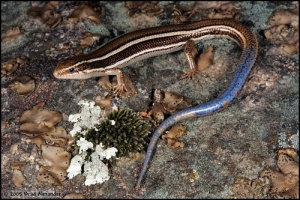Difference between revisions of "Ecological Speciation in North American Scincid Lizards"
| Line 1: | Line 1: | ||
| − | [[Image:Jon_Richmond.jpg|left|thumb|Jonathan Richmond]]My research focuses on ecological speciation in North American scincid lizards of the '' | + | [[Image:Jon_Richmond.jpg|left|thumb|Jonathan Richmond]]My research focuses on ecological speciation in North American scincid lizards of the ''Plestiodon skiltonianus'' species complex. Specifically, I am interested in understanding how divergent natural selection has influenced the evolution of reproductive incompatibility among clades that differ in their ecology. Although most classic theories of speciation incorporate a role for natural selection in species formation, remarkably few cases of ecological speciation have been demonstrated in natural systems, and the importance and prevalence of natural selection in the speciation process remains an open ended question. |
Parallel morphological evolution in organisms occupying similar environments often indicates that the phenotypic changes are a result of natural selection, thus serving as a potential signature for ecological speciation. In a few animal groups, parallelisms have lead to an unusual situation in which traits that impose restrictions on gene flow evolve repeatedly and independently in closely related lineages as a by-product of natural selection. The outcome of such parallel speciation is that ecologically divergent but closely related populations show higher levels of reproductive incompatibility than ecologically similar but distantly related ones. | Parallel morphological evolution in organisms occupying similar environments often indicates that the phenotypic changes are a result of natural selection, thus serving as a potential signature for ecological speciation. In a few animal groups, parallelisms have lead to an unusual situation in which traits that impose restrictions on gene flow evolve repeatedly and independently in closely related lineages as a by-product of natural selection. The outcome of such parallel speciation is that ecologically divergent but closely related populations show higher levels of reproductive incompatibility than ecologically similar but distantly related ones. | ||
| − | [[Image:Eumeces_skiltonianusSLO_small.jpg|right|thumb|'' | + | [[Image:Eumeces_skiltonianusSLO_small.jpg|right|thumb|''Plestiodon skiltonianus'']]The ''skiltonianus'' complex is a candidate example of parallel speciation and consists of two ecomorphs that differ in body size, coloration, and ecology. Historically, the two ecomorphs were considered to be distinct species, ''P. gilberti'' and ''P. skiltonianus'', each having several recognized subspecies within them. Phylogenetic analyses of mtDNA data provide strong evidence that the large, arid adapted ecomorph (''gilberti'') has evolved as many as three times independently from within the smaller, mesic adapted ecomorph (''skiltonianus''), indicating that ''P. gilberti'' more likely represents three species that share a common ecomorphology. Although these clades appear to be separate species from the perspective of mtDNA, several lines of evidence indicate that two of the gilberti clades are interbreeding in a secondary contact zone in the southern Sierra Nevada Mountains of California. The extent of gene flow between these clades is currently unknown. |
| − | [[Image:Eumeces_grubricaudatus4_small.jpg|right|thumb|'' | + | [[Image:Eumeces_grubricaudatus4_small.jpg|right|thumb|''Plestiodon gilberti'']]This an unusual situation in nature given that divergent selection is potentially responsible for not only the formation of new species within the ''skiltonianus'' complex, but also the potential degradation of species as a consequence of gene flow between clades with parallel evolved ecotypes. However, to demonstrate that this system represents an example of parallel ecological speciation, independently derived lineages of the same ecomorph must be shown to be reproductively compatible (i.e. ''gilberti'' vs. ''gilberti''), whereas morphologically divergent lineages occurring in different environments must be reproductively isolated (i.e. ''gilberti'' vs. ''skiltonianus''). My dissertation is comprised of three primary topics, each aimed at assessing levels of sexual compatibility within and across ecomorphs. These include, (1) measuring gene flow across populations and contact zones using AFLP and mtDNA, (2) performing laboratory mate choice experiments to evaluate the effects of phylogenetic relatedness, geographic distance, and body morphology on copulation success, and (3) quantifying morphological variation to test whether character displacement has occurred between ecomorphs in sympatry and to evaluate the similarity of parallel evolved morphs. |
---- | ---- | ||
Latest revision as of 20:45, 29 January 2007
My research focuses on ecological speciation in North American scincid lizards of the Plestiodon skiltonianus species complex. Specifically, I am interested in understanding how divergent natural selection has influenced the evolution of reproductive incompatibility among clades that differ in their ecology. Although most classic theories of speciation incorporate a role for natural selection in species formation, remarkably few cases of ecological speciation have been demonstrated in natural systems, and the importance and prevalence of natural selection in the speciation process remains an open ended question.Parallel morphological evolution in organisms occupying similar environments often indicates that the phenotypic changes are a result of natural selection, thus serving as a potential signature for ecological speciation. In a few animal groups, parallelisms have lead to an unusual situation in which traits that impose restrictions on gene flow evolve repeatedly and independently in closely related lineages as a by-product of natural selection. The outcome of such parallel speciation is that ecologically divergent but closely related populations show higher levels of reproductive incompatibility than ecologically similar but distantly related ones.
The skiltonianus complex is a candidate example of parallel speciation and consists of two ecomorphs that differ in body size, coloration, and ecology. Historically, the two ecomorphs were considered to be distinct species, P. gilberti and P. skiltonianus, each having several recognized subspecies within them. Phylogenetic analyses of mtDNA data provide strong evidence that the large, arid adapted ecomorph (gilberti) has evolved as many as three times independently from within the smaller, mesic adapted ecomorph (skiltonianus), indicating that P. gilberti more likely represents three species that share a common ecomorphology. Although these clades appear to be separate species from the perspective of mtDNA, several lines of evidence indicate that two of the gilberti clades are interbreeding in a secondary contact zone in the southern Sierra Nevada Mountains of California. The extent of gene flow between these clades is currently unknown. This an unusual situation in nature given that divergent selection is potentially responsible for not only the formation of new species within the skiltonianus complex, but also the potential degradation of species as a consequence of gene flow between clades with parallel evolved ecotypes. However, to demonstrate that this system represents an example of parallel ecological speciation, independently derived lineages of the same ecomorph must be shown to be reproductively compatible (i.e. gilberti vs. gilberti), whereas morphologically divergent lineages occurring in different environments must be reproductively isolated (i.e. gilberti vs. skiltonianus). My dissertation is comprised of three primary topics, each aimed at assessing levels of sexual compatibility within and across ecomorphs. These include, (1) measuring gene flow across populations and contact zones using AFLP and mtDNA, (2) performing laboratory mate choice experiments to evaluate the effects of phylogenetic relatedness, geographic distance, and body morphology on copulation success, and (3) quantifying morphological variation to test whether character displacement has occurred between ecomorphs in sympatry and to evaluate the similarity of parallel evolved morphs.Jonathan Richmond received his Ph.D. degree from EEB in 2006 and is now a postdoctoral researcher in the lab of Kelly Zamudio at Cornell.


